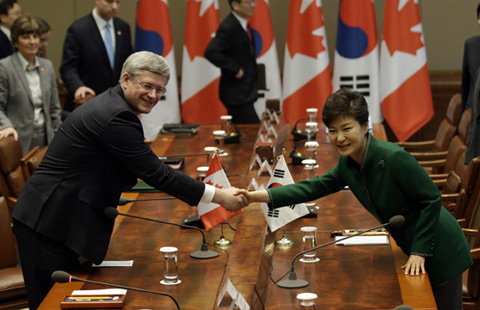Modern merchants follow famous footsteps
Updated: 2014-03-14 07:40
By Cui Jia (China Daily)
|
||||||||
China has proposed a modern version of one of the ancient world's best-known trade routes, as Cui Jia reports.
The Silk Road. The very name conjours up images of hardy, courageous merchants fighting off bandits and warring tribesmen as their caravans, carrying exotic silks and spices, ventured warily along a series of ancient trade routes that stretched more than 7,000 kilometers from China to the Mediterranean Sea and provided a connection between East and West for centuries.
Now, plans are afoot to bring back the glory days, but instead of camels, the modern travelers will use automobiles, trains and aircraft to traverse a route that was responsible for the settlement and development of some of the greatest cities known to the ancient world.
In 2013, during a speech in Kazakhstan, President Xi Jinping proposed that China and the Central Asian countries should build an "economic belt along the Silk Road". The trans-Eurasian project would target more than 3 billion people and represent the single biggest market in the world, one with unparalleled potential.
In his work report at the start of the second session of the 12th National People's Congress, Premier Li Keqiang stated that the government will push forward the establishment of the Silk Road Economic Belt, which may eventually encompass more than 40 countries.
Sun Weidong, a consular official at the Chinese embassy in Kazakhstan, said the economic belt will mainly benefit China's underdeveloped western region and will become an updated version of the "Go West" strategy of the early years of this century. In addition, the government hoped that the project will open up western China to Eurasian countries and correct the developmental imbalance with the coastal regions in the east.
Fierce competition
While Sun admitted that a lack of policy support and detailed guidance from the central government will initially pose problems for the development of the project, he was adamant that cities on the proposed route will be in fierce competition to grab a piece of the pie.
Dong Jun, mayor of Xi'an, the capital of Shaanxi province, the original starting point of the ancient Silk Road, said the city is anxious to reclaim its position as a hub of trade and cultural communications.
"The corporations in the cities within the economic belt have great potential, and we can complement each other's economies," Dong said, adding that Xi'an plans to invite Central Asian countries to set up consulates in the city to deepen cooperation.
As with any venture of this kind, an efficient transport infrastructure will be at its heart. As such, Xi'an plans to launch direct flights to Astana, the capital of Kazakhstan, and Ashgabat, the capital of Turkmenistan, to promote the surveying and drilling equipment manufactured in the city to countries in central and western Asia, Dong said.
Tang Zongwei, deputy director of the administrative committee of Liangjiang New Zone in Chongqing, the only municipality in China's midwest, said: "The focus of the construction of the Silk Road Economic Belt relies heavily on transport connections."
Huang Qifan, the municipality's mayor, said, "Chongqing is one step ahead in taking the initiative in the economic belt." He pointed out that the municipality has been shipping goods to Europe via the trans-Eurasian railway network since 2011.
The Chongqing-Xinjiang-Europe international railway, which begins at Chongqing, bridges East and West and connects North and South. Trains on the network take just 14 to 15 days to get to Europe, 20 days fewer than the cargo ships that sail from China's east coast ports. That makes rail an ideal transport medium for goods with a relatively shorter shelf life, he said.
The railway passes through Xi'an, Lanzhou, Urumqi and the Alataw Pass, where it crosses the border into Kazakhstan. It then continues through Russia, Belarus and Poland before ending in Duisburg, Germany.
Chongqing has already started to seek cooperation with Russia, which is about to establish a consulate in the municipality. Direct flights to several Russian cities will begin in 2014, and a Sino-Russian industrial park will be built in Liangjiang New Zone that focuses on aviation-related manufacturing, such as helicopter parts and engines.
Cultural leader
Further to the northwest, preparations are also underway in Gansu province, which, in addition to the potential trade benefits the economic belt will bring, is also keen to become a leader in the cultural sphere. To that end, the province is applying to launch a permanent International Culture Exhibition in Dunhuang city, which is famous for its well-preserved grottoes and frescoes, said Lian Ji, head of the provincial Publicity Department.
"The exhibition will invite other countries along the Silk Road to participate, and we hope the central government and the relevant ministries will approve the proposal soon," he said.
Zhang Shi'en, deputy head of the provincial commerce department, stressed that the province is already a well-established trade partner in the region. "Trade between Gansu and countries in central and western Asia reached $1.5 billion in 2013, an increase of almost $400 million from 2012," he said. Gansu has also established "sister" relationships with Iran's Qom province and Grodno province in Belarus.
Liu Hui, chairman of the Ningxia Hui autonomous region, said the area's large Muslim population means it shares cultural ties with several countries in central Asia and Arabia, which play crucial roles in the world's energy sector. The region is also seeking deeper international cooperation in the halal food industry, he added.
As the home of the westernmost section of the Eurasian Land Bridge at the Chinese end, the Xinjiang Uygur autonomous region will exploit its location on the new Silk Road to become a major center for transport, finance and logistics.
In 2010, a special economic zone was established in Kashgar. It acts as a trade hub for the region and neighboring countries, including Pakistan and Kazakhstan. A twin-towered five-star hotel and duty-free shopping area is under construction in the zone.
"We cannot deny that the terrorist attacks in Kashgar have affected investor confidence to a certain degree, but when businesspeople learn about our preferential policies and understand the economic belt's potential, they will continue to invest," said Yao Wenkan, director of the zone's economic development and reform bureau.
In 2012, a free trade zone was established in the town of Horgos on the China-Kazakhstan border. It provides cross-border trade tariff exemptions for Chinese companies and duty-free shopping for visitors.
Xinjiang's two special zones are expected to play important roles within the proposed economic belt, said Mutalif Wubuli, the commissioner of Kashgar prefecture, a transcontinental hub on the ancient trade route. "The cities on the new Silk Road need to clearly position themselves and take advantage of their specialties instead of repeatedly proposing identical projects," he said.
Earlier this week, Zhang Chunxian, Party chief of Xinjiang and a member of the CPC Central Committee Political Bureau, said the central government's policies for the economic belt will be released soon.
The view from afar
Other countries linked to the proposed economic belt are also taking steps to make the idea become a reality.
Ramazan Kabasakal, head of foreign relations for Ankara, the capital of Turkey, said: "Xinjiang shares strong cultural, religious and cultural ties with Turkey, which makes us almost a home away from home for Xinjiang businesspeople. These ties are advantageous in terms of trade and cooperation."
Ankara was once an important stop on the ancient Silk Road and it will play the same role in the economic belt, acting as a transport hub between Europe and the East, he said.
"We mainly import construction materials and export food products from and to China. What makes us proud is that we now export high-end silk products to China, a country that was once famous for its silk," he added.
Orozbek Nusuvaliev, manager of the economic free-trade development zone in Bishkek, the capital of Kyrgyzstan, said the Kyrgyz government is very interested in the idea of an economic belt along the old Silk Road and is considering introducing national policies to support it.
Seyed Solat Mortazavi, the mayor of the Iranian city of Mashhad, a major oasis on the original route, said, "We have had a vision of the economic belt and now we need to define that vision.
"It will serve as a common development platform for all the cities that once prospered as a result of the free flow of people along the ancient trade route. To recapture those glory days, we will launch direct flights to Urumqi, the capital of Xinjiang," he said.
In addition to building closer relationships between governments, bringing people together through tourism would also be an important function of the economic belt, he said. "We will adopt preferential polices to give full support to the idea proposed by President Xi, but China and other countries need to lay out a step-by-step road map so we can follow it together."
He expressed the hope that China will impose strict rules to prevent low-quality goods from being traded within the economic belt.
Energy security
He Lunzhi, director of Xinjiang University's economic research center, said the Silk Road economic belt is not just about trade and cultural exchanges, because Central Asian markets are quite small and are still relatively underdeveloped; the bigger picture is that China needs to secure its energy supply and seek better cooperation in fighting terrorism. Central Asia - known as "the energy resource base of the 21st century, " according to He - boasts abundant natural resources.
"China needs to expand the channels and sources for oil imports because imported oil will account for 75 percent of domestic consumption by 2020," He said. "The countries on the 'new Silk Road' must work together to maintain the stability of the region and help China to combat separatist, extremist and terrorist forces," he added.
Terrorist activities in China have become more prevalent in recent years. Attacks have spread from the areas bordering Afghanistan, Pakistan and Russia and have triggered panic among the public and endangered state security, according to Wu Dongli, director of the Ministry of Public Security's border control bureau.
"China needs to strengthen international cooperation in fighting terrorism. Stronger trade and cultural relationships with other countries in the region would be hugely beneficial for those aims," he said.
Contact the writer at cuijia@chinadaily.com.cn
Luo Wangshu, Gao Qihui, Shan Juan and Wang Huazhong contributed to this story.
(China Daily 03/14/2014 page10)

 Cooperation at the heart of win-win, Li tells world
Cooperation at the heart of win-win, Li tells world
 Prayers for missing flight MH370
Prayers for missing flight MH370
 US first lady promotes film
US first lady promotes film
 Who's got the No 1 Chinatown in the US?
Who's got the No 1 Chinatown in the US?
 Obama sweats over sweaters during shopping
Obama sweats over sweaters during shopping
 Chinese arcade games on display
Chinese arcade games on display
 Photos of stolen passport holders released
Photos of stolen passport holders released
 S Korea, Canada signs comprehensive FTA
S Korea, Canada signs comprehensive FTA
Most Viewed
Editor's Picks

|

|

|

|

|

|
Today's Top News
Satellite images not of MH370 crash: officials
Nevada woos Chinese investment
China defends South China Sea action
Nobel laureate: Beijing reform policies 'dynamic and flexible'
NYC gas blast: 3 dead, 9 missing
Malaysia air tragedy: Justice will come, someday
US faces new challenge in critical market
Report: Plane may have flown on for hours
US Weekly

|

|







